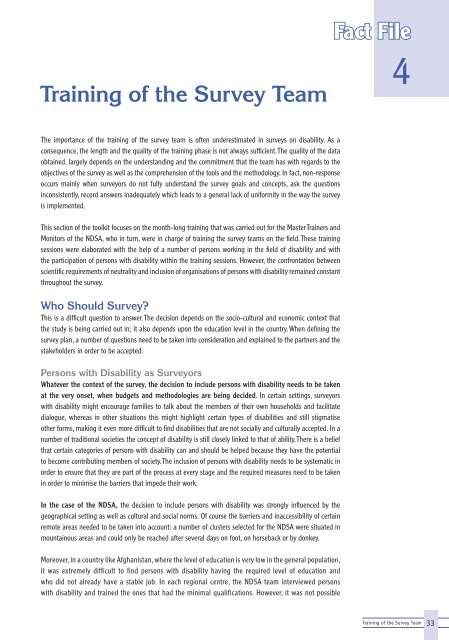Conducting Surveys on Disability: A Comprehensive Toolkit
Conducting Surveys on Disability: A Comprehensive Toolkit
Conducting Surveys on Disability: A Comprehensive Toolkit
You also want an ePaper? Increase the reach of your titles
YUMPU automatically turns print PDFs into web optimized ePapers that Google loves.
Fact File<br />
Training of the Survey Team<br />
4<br />
The importance of the training of the survey team is often underestimated in surveys <strong>on</strong> disability. As a<br />
c<strong>on</strong>sequence, the length and the quality of the training phase is not always sufficient. The quality of the data<br />
obtained, largely depends <strong>on</strong> the understanding and the commitment that the team has with regards to the<br />
objectives of the survey as well as the comprehensi<strong>on</strong> of the tools and the methodology. In fact, n<strong>on</strong>-resp<strong>on</strong>se<br />
occurs mainly when surveyors do not fully understand the survey goals and c<strong>on</strong>cepts, ask the questi<strong>on</strong>s<br />
inc<strong>on</strong>sistently, record answers inadequately which leads to a general lack of uniformity in the way the survey<br />
is implemented.<br />
This secti<strong>on</strong> of the toolkit focuses <strong>on</strong> the m<strong>on</strong>th-l<strong>on</strong>g training that was carried out for the Master Trainers and<br />
M<strong>on</strong>itors of the NDSA, who in turn, were in charge of training the survey teams <strong>on</strong> the field. These training<br />
sessi<strong>on</strong>s were elaborated with the help of a number of pers<strong>on</strong>s working in the field of disability and with<br />
the participati<strong>on</strong> of pers<strong>on</strong>s with disability within the training sessi<strong>on</strong>s. However, the c<strong>on</strong>fr<strong>on</strong>tati<strong>on</strong> between<br />
scientific requirements of neutrality and inclusi<strong>on</strong> of organisati<strong>on</strong>s of pers<strong>on</strong>s with disability remained c<strong>on</strong>stant<br />
throughout the survey.<br />
Who Should Survey<br />
This is a difficult questi<strong>on</strong> to answer. The decisi<strong>on</strong> depends <strong>on</strong> the socio-cultural and ec<strong>on</strong>omic c<strong>on</strong>text that<br />
the study is being carried out in; it also depends up<strong>on</strong> the educati<strong>on</strong> level in the country. When defining the<br />
survey plan, a number of questi<strong>on</strong>s need to be taken into c<strong>on</strong>siderati<strong>on</strong> and explained to the partners and the<br />
stakeholders in order to be accepted.<br />
Pers<strong>on</strong>s with <strong>Disability</strong> as Surveyors<br />
Whatever the c<strong>on</strong>text of the survey, the decisi<strong>on</strong> to include pers<strong>on</strong>s with disability needs to be taken<br />
at the very <strong>on</strong>set, when budgets and methodologies are being decided. In certain settings, surveyors<br />
with disability might encourage families to talk about the members of their own households and facilitate<br />
dialogue, whereas in other situati<strong>on</strong>s this might highlight certain types of disabilities and still stigmatise<br />
other forms, making it even more difficult to find disabilities that are not socially and culturally accepted. In a<br />
number of traditi<strong>on</strong>al societies the c<strong>on</strong>cept of disability is still closely linked to that of ability. There is a belief<br />
that certain categories of pers<strong>on</strong>s with disability can and should be helped because they have the potential<br />
to become c<strong>on</strong>tributing members of society. The inclusi<strong>on</strong> of pers<strong>on</strong>s with disability needs to be systematic in<br />
order to ensure that they are part of the process at every stage and the required measures need to be taken<br />
in order to minimise the barriers that impede their work.<br />
In the case of the NDSA, the decisi<strong>on</strong> to include pers<strong>on</strong>s with disability was str<strong>on</strong>gly influenced by the<br />
geographical setting as well as cultural and social norms. Of course the barriers and inaccessibility of certain<br />
remote areas needed to be taken into account: a number of clusters selected for the NDSA were situated in<br />
mountainous areas and could <strong>on</strong>ly be reached after several days <strong>on</strong> foot, <strong>on</strong> horseback or by d<strong>on</strong>key.<br />
Moreover, in a country like Afghanistan, where the level of educati<strong>on</strong> is very low in the general populati<strong>on</strong>,<br />
it was extremely difficult to find pers<strong>on</strong>s with disability having the required level of educati<strong>on</strong> and<br />
who did not already have a stable job. In each regi<strong>on</strong>al centre, the NDSA team interviewed pers<strong>on</strong>s<br />
with disability and trained the <strong>on</strong>es that had the minimal qualificati<strong>on</strong>s. However, it was not possible<br />
Training of the Survey Team<br />
33

















